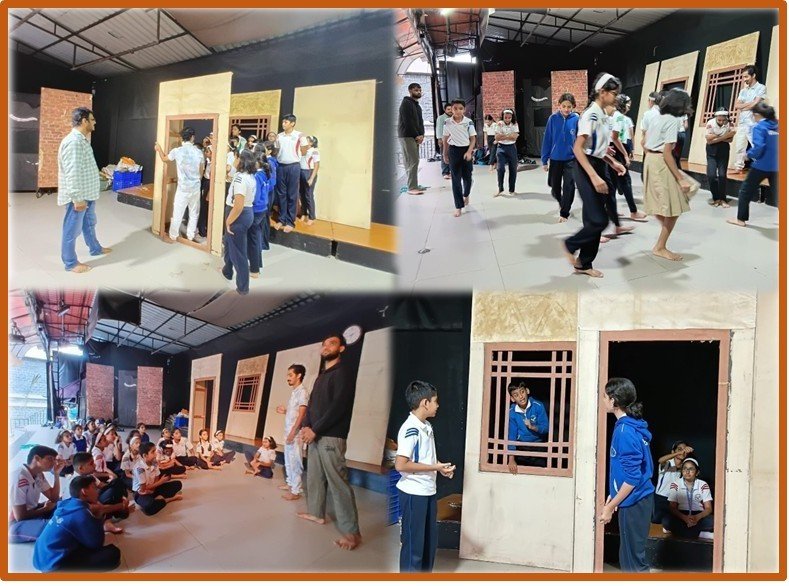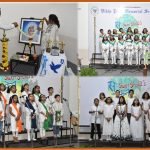
Dramatic Dreamers Club
Report of the Third Session
Date: 26th July 2025
Venue: Shri Mahavir Jain Vidyalaya (SMJV) Swatantra Theatre
Facilitator: Abhijit sir, Prem, Pravesh, and Huzaif of Swatantra Theatre
Classes Involved: VI to IX
Theme of Session 3: Body Language & Expressions
Session Highlights:
Exercise & Flexibility-Gymnastics-based flexibility training.
Qualities and Abilities- Theory session in which the qualities and abilities of an actor were explained.
Set, Properties, Lights and Sound– Types were explained and shown to students.
Improvisation– Pick any prop from the premises and perform a short act or movement piece
Session 3 focused on physicality and the expressive potential of the body in drama. Students were introduced to stage presence, posture, and movement through a series of structured exercises and games. They had to walk while reciting dialogues, run and stop to control body movement. Pretending to walk on rose petals strewn on the ground, walking softly and noiselessly and speaking dialogues all throughout. Next, they had to imagine they were walking on pieces of ice, with their feet freezing, getting numb and hurt in the process. Lastly, they had to imagine they were walking on embers of fire that burned their feet. The theory regarding the big team that is required to set up a drama was shared. It includes auditorium rental, costume, and properties among others. As an example, it was mentioned that FTII levies Rs 500 as fine for losing a needle. This is done to inculcate responsibility.
The set is made of wood and cloth that is painted. The pieces of wood are then tied together with ropes to make it stand upright. Consequently, the set stays the same throughout. The duration of most plays is generally 2.5 hours. Nowadays, there are dramas that are for only 1.5hours. Lights must be taken by the actors themselves not given by the person in charge of lights. The actor must be visible to the audience. 1000 watts bulbs are used on stage. Students learnt how to diagonally tie the different parts of the set tightly together. Ropes are tied to the nails hammered to the sides and the other nails are for hanging other props like a photo frame or clock etc. There are various types of lights- cannon lights and shoot lights, spot, profile, par can which is conical and sharp, and the water drum etc.
The basic light is the spot which is less harsh for the actors. Pars are heavy and hot for showing the stage and props. E.g. To show a road, 2 pars in 2 corners are used to converge together to indicate a road. LED background detracts from creativity. Actors must get used to the glare. The same prop can be reused. The spotlight must hurt your eyes a bit, then the actor’s position on stage is correct. There are generally 8 spotlights given. Black, blue, magenta lights are used to depict nighttime. Light, sound, set, actor, and properties are the 5 departments of theatre. The objects that are movable are called props and what is fixed is the set. Set is used either to the left, right or up stage.
There are 16 abilities of actors. 3 were dealt with today- viz. rhythm (pattern, flow or structure) of speaking, walking and stopping. An actor must be very observant to decide his rhythm, which is the first ability. The second ability is timing. Immediately after one actor says his part, the second actor must respond either instantly or after 2-3 seconds of pause. The third ability is pace. This is the frequency in which we speak. It depends on the emotions.
Improvisation- The students had to use the words “door” and “window” in their performance and use the door and window as their set.
The policy of NSB- Never Show Your Back was emphasized.
Lastly, students were made to inhale, exhale and keep their eyes shut and listen to the sounds around them. There are different layers of sound. Students were asked subsequently what they could hear.
Learning Outcome:
By the end of the session, students were able to demonstrate improved physical expressiveness and stage presence through purposeful movement and facial expressions. They effectively applied elements learnt in scene work, showing an increased awareness of how non-verbal cues can convey character, emotion, and intent on stage.
If you wish to be a leader, you must learn drama and theatre.




